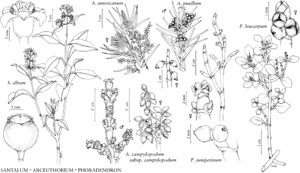Arceuthobium
Fl. Taur.-Caucas. 3: 629. 1819.
Herbs or subshrubs, dioecious; parasitic on branches of Pinaceae [Cupressaceae], infections localized, nonsystemic, or systemic, sometimes inducing witches’ brooms. Stems multiple; primary branching fanlike, secondary branching fanlike or whorled. Leaves scalelike, connate. Inflorescences axillary or terminal, spikelike thyrses; flowers borne singly or in cymes in axils of subtending scales, not in cavities or grooves. Staminate flowers: petals 3–4 (–6), triangular, distinct, radially symmetric or slightly asymmetric; stamens 3–4 (–6); anthers 1-locular, dehiscing by transverse-slits; nectary (= central cushion) present. Pistillate flowers: petals 2 (–3), deltate, connate basally; ovary 1-locular; style very short to absent; stigma 2-lobed, secreting pollination droplet. Berries borne on recurved pedicels (when mature), explosively dehiscent from pedicellar end, 2-colored, smooth, glaucous, petal remnants not persisting. Seeds sticky when fruit dehisces, mucilaginous later after imbibing water; endosperm globose to pyriform; embryo oriented longitudinally. x = 14.
Distribution
North America, Mexico, West Indies, Central America, Eurasia, Africa, Atlantic Islands
Discussion
Species 29 (7 in the flora).
Species of Arceuthobium have received much attention because of their negative impact on commercially important conifers, and also because of their fascinating life history. Most mistletoes rely on birds to disperse their seeds, but in all but one species of Arceuthobium (A. verticilliflorum Engelmann from Durango, Mexico), seeds are dispersed by explosive dehiscence. Another feature considered an evolutionary advancement is reduced photosynthesis accompanying greater dependence on host carbon. Arceuthobium can be considered on the brink of becoming a holoparasite (D. L. Nickrent and M. A. García 2009). It can form three basic types of infections on the host. The first, called a localized infection, is present as the mistletoe shoots emerge from an often swollen host branch at the original site of seedling penetration. In some species, the infections remain localized, but in many species they later develop into witches' brooms, with the parasite inducing prolific branching of the host distal to the point of infection. With nonsystemic witches' brooms, the mistletoe endophyte remains localized; whereas with systemic witches’ brooms, the parasite endophyte occurs within the broom, sometimes existing adjacent to and dividing in synchrony with the host apical meristem (J. Kuijt 1960).
Arceuthobium has long been considered a taxonomically difficult group, mainly owing to losses and reductions in morphologic features used for classification. L. S. Gill (1935) was the first to propose a comprehensive treatment of the genus in the United States. In their classification, F. G. Hawksworth and D. Wiens (1972) utilized many of the same features as Gill, such as branching pattern, but did not agree with his host-form concept. Host specificity in Arceuthobium ranges from specialists (only one host known) to generalists that parasitize over a dozen species. Hawksworth and Wiens and D. L. Nickrent (1996) strongly advocated that mistletoe morphologic integrity was maintained irrespective of host being parasitized, and recognized 28 and 42 species, respectively.
A classification of Arceuthobium, revised from D. L. Nickrent (1996), was given by Nickrent et al. (2004), who recognized 26 species in two subgenera and 11 sections. That system is followed here, considering only subg. Vaginata Hawksworth & Wiens because all North American Arceuthobium reside there. This classification differs most from F. G. Hawksworth and D. Wiens (1972) with regard to sect. Campylopoda Hawksworth & Wiens; whereas the latter authors recognized 13 species in this section, Nickrent et al. recognized only two.
Selected References
Lower Taxa
Key
| 1 | Secondary branching whorled; staminate pedicels present; lateral staminate flowers subglobose in bud; flowering (Mar–)Apr–Jun; principal hosts Pinus banksiana and P. contorta. | Arceuthobium americanum |
| 1 | Secondary branching fanlike; staminate pedicels absent (present in A. douglasii); lateral staminate flowers lenticular or subglobose in bud; flowering Feb–Dec; hosts various Pinaceae. | > 2 |
| 2 | Flowering Jul–Dec. | > 3 |
| 3 | Parasites of pinyon pines (principally Pinus edulis and P. monophylla). | Arceuthobium divaricatum |
| 3 | Parasites of other Pinaceae (Abies, Picea, Pinus, Larix, and Tsuga). | Arceuthobium campylopodum |
| 2 | Flowering Feb–Jun(–Jul). | > 4 |
| 4 | Lateral staminate flowers subglobose in bud; plants forming systemic witches’ brooms; principal host Pseudotsuga menziesii. | Arceuthobium douglasii |
| 4 | Lateral staminate flowers lenticular in bud; plants forming localized infections or systemic or nonsystemic witches' brooms; principle hosts Picea and Pinus. | > 5 |
| 5 | Secondary branches (1–)3 cm, rarely seen; plants forming systemic witches’ brooms; principal host Picea; e North America. | Arceuthobium pusillum |
| 5 | Secondary branches 8–20(–27) cm; plants forming localized infections or nonsystemic witches’ brooms; w North America. | > 6 |
| 6 | Staminate and pistillate plants dimorphic; principal host Pinus leiophylla var. chihuahua; Arizona, New Mexico. | Arceuthobium gillii |
| 6 | Staminate and pistillate plants not dimorphic; principal hosts primarily Pinus ponderosa, sometimes P. arizonica, P. durangensis, and P. engelmannii); w United States. | Arceuthobium vaginatum |
